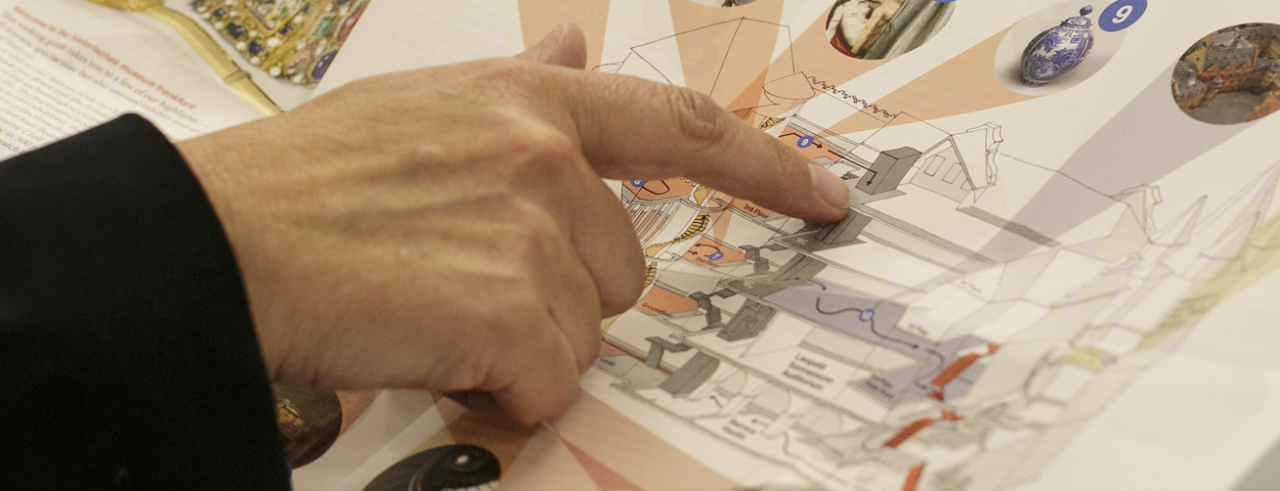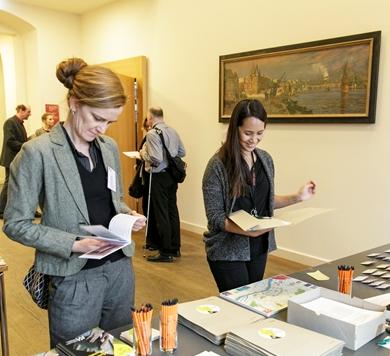
Guiding principle of inclusion
In our house, a wide variety of social and cultural groups, people with a wide variety of mental and physical conditions are welcome to engage with Frankfurt's history, present and future – spontaneously and independently and not only within the framework of special programs.
This is the guiding principle on which the museum staff have agreed. As an "inclusive museum", the HMF is even more committed than before to the goal of appealing to all population groups with its exhibition design, its program and its collection. The exhibitions are made for the visitors and their needs have a high priority. In its planning, the museum has responded to the UN Convention on the Rights of Persons with Disabilities, which came into force in 2009. Its aim is to remove existing barriers in buildings, public transport and the provision of information in order to enable all people to lead a self-determined life. Holistic concept of inclusion
The museum has taken these demands a step further. It starts from a "holistic concept of inclusion" as a "universal human rights principle of social coexistence" (Gudrun Wansing, 2015). Not only people with special needs (be they permanent or temporary) benefit from the accessibility and usability of the conveyed content, from sufficient seating, a clear guidance system, easily readable and comprehensible texts, from offers that appeal to all senses, from sensitive on-site staff or a barrier-free website to prepare the museum visit – but all museum visitors. Inclusive offers are not special offers for people with disabilities; that would in turn create exclusion. The understanding of the HMF as an "inclusive museum" is rather the answer to the heterogeneity of the museum visitors.Thinking inclusion along
Numerous elements of the new museum are accessible to people with special needs through sometimes simple means – these just had to be "thought into". Examples of this are: the exhibition furniture was designed so that it can be moved underneath for better viewing and operation with a wheelchair, sufficient seeting was planned, within the exhibition signage in concise lettering and color serves as an orientation aid, and the rooms are designed with high contrasts. Anchor media stations are equipped with two superimposed loudspeakers (each at sitting and standing height) and are also accessible to people with visual impairments by means of tactile buttons or a lenticular recess in the surface of the touchscreen as well as an explanatory announcement at the audio stations. Video stations are subtitled for visitors with hearing disabilities (which also benefits people who speak German only as a foreign language). So-called "hands-on stations" in th new permanent exhibitions offer holistic and/or playful access or opportunities to deepen the content of the exhibitions. All central exhibition contents are conveyed in a multi-sensory manner – i.e. at least two senses are always addressed.Measures for blind and visually impaired museum visitors
Blind and visually impaired visitors should not only be able to take part in special educational offers, but also to visit the museum spontaneously and, if desired, without an accompanying person. A tactile model at the foot of the staircase below the museum square serves as a first orientation through the building complex. This is integrated into a guidance system for the blind on the floor, which leads to the museum ticket office. Both also facilitate orientation for sighted visitors. Inside the museum, the guidance system, which can be felt with a cane for the blind, makes it possible to move independently through the exhibition rooms. The system of ribs and studs on the floor, supplemented by tactile floor plans (completion spring 2019), leads to objects that may be touched and to specially prepared models.A double-size cast of the "Schöner globe" from 1515, a highlight in the HMF collection, was made – touchable, rotatable, with high-contrast color design, with Braille lettering and accompanying tactile book. On it, all museum visitors can discover the numerous exciting details of this culturally and historically important exhibit. In the exhibition area "Money City", a total of 10 special coins from the collection have been prepared for visually inpaired visitors. A tactile model in the outdoor area allows visitors to experience the Stauferhafen, a medieval quay wall found during the construction of the new museum building.
All these elements can be experienced by visitors through a very special tour on the multimedia guide. When you select it, you follow a dialogic guided tour by museum curator Anne Gemeinhardt and blind museum consultant Annalena Knors. Here, tracks for orientation in the house and content-related tracks to the respective stations alternate and enable the visitors to visit the exhibitions as independently and enjoyable as possible.
Multimedia guide and personal mediation
The multimedia guide is the most important tool for mobile mediation of the museum contents to various target groups. Tours have been created from about 20 individual museum objects each, which guide visitors through the museum according to target groups (tourists, Frankfurt residents, families) and/or topics (e.g. Frankfurt under National Socialism, migration history, design history).Multimedia guided tours are also available for people with sensory impairments: a detailed descriptive audio tour for visitors with a visual impairment, a video tour in German sign language for people with a hearing impairment, and a tour in easy-to-understand language (which may also be suitably for visitors with little knowledge of German). The development of the tours together with experts on their own behalf is of central importance.
Informaton offered by people with disabilities opens up new horizons for all visitors. In the HMF it should not be an "exotic" offer to be accompanied by a blind guide through the city history exhibition, but it is part of the "normal" mediation offer for a heterogeneous museum audience.
Inclusion is established and anchored as a fundamental principle in our museum.
Cooperation partners
Association for the Blind and Visually Impaired in Hessen e.V.blista (German Institute for the Blind) e.V., Marburg
Inclusion Office of the City of Frankfurt am Main
Frankfurt Foundation for the Deaf and Hard of Hearing
Praunheimer Werkstätten GmbH
Network Inclusion Frankfurt
Frankfurt House of Literature
Lebenshilfe Frankfurt e.V.
Partners of the project "Inclusive Museum"
Hessian Ministry for Social Affairs and IntegrationCity of Frankfurt am Main, Department for Social Affairs, Senior Citizens, Youth and Law
Rotary Frankfurt
Hessian Museum Association
Foundation Polytechnische Gesellschaft Frankfurt
Ursula Ströher Foundation
Freunde & Förderer of the Historical Museum

